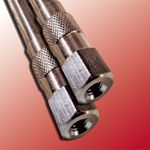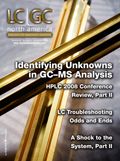Odds and Ends from the Inbox
LCGC North America
John Dolan regularly receive e-mails from readers with a wide variety of questions. As he cleans out his inbox, he chooses a few of these to share.
I regularly receive e-mails from readers with a wide variety of questions. Some of these blossom into full-blown columns, but many are answered with just a short response. As I cleaned out my inbox recently, I chose a few of these to share. There is no central theme this month, but hopefully you will pick up some useful information from these topics related to practical operation of the liquid chromatography (LC) system.

John W. Dolan
Should I use a Guard Column or an In-Line Filter?
If you are a regular reader of "LC Troubleshooting," you will know that I am a strong proponent of using an in-line filter to protect the LC column. The filter contains a frit, most commonly 0.5 μm in porosity, and is mounted directly downstream from the autosampler. Its purpose is to trap the stray particle that can be injected with the sample or that results from pump-seal or injector-rotor wear. Columns packed with 5-μm diameter particles use 2-μm porosity frits to hold the particles in the column, and 3-μm particle columns use 0.5-μm frits on the outlet and either 0.5- or 2-μm frits on the inlet. Thus, the 0.5-μm in-line filter will catch any particles that would otherwise block the frit at the head of the column packed with 3- or 5-μm particles. When the system pressure rises significantly, for example by 25%, change the frit for a new one and you should be back in business. For columns packed with sub-2-μm particles, 0.2-μm frits are used in the column, so the in-line filter porosity should be no larger than this or it will not be effective. Two common filter designs are available. One comprises a reusable holder that is disassembled to replace the frit. The other is a disposable unit that screws into the end of the column. I believe that the in-line filter is the least expensive way to protect the column from blockage.

Guard columns have frits at both ends, so they also act as in-line filters. The packing material in the guard column should be selected to match the guard column (same stationary phase type, such as C18, and from the same manufacturer). This packing will trap materials that otherwise would bind irreversibly to the top of the analytical column, thus, extending analytical column life. My problem with guard columns is that, at best, they do not degrade the separation, and more typically, they slightly reduce the column efficiency and resolution. You might think that the additional column length contributed by the guard column might improve the separation, but guard columns are not well packed and the additional fittings can add extracolumn volume. An additional challenge is to determine when the guard column needs to be replaced — most workers do this on a time-in-use or samples-injected basis, both of which require a little more record keeping. Furthermore, guard columns are fairly expensive, so I have a hard time justifying the extra cost for the benefits I receive. As a result, I don't use a guard column unless I'm using a method developed by someone else that designates guard column use. You are welcome to use a guard column, it just isn't my first choice. If you do use a guard column, I still recommend installing an in-line filter between the autosampler and the guard column.
Is Manual Integration Permissible?
I often get asked if it is OK to use manual integration for a chromatogram. I think this question arises from an incomplete understanding of the integration process and the regulations about modifying data. If peaks are large, such as those with signal-to-noise ratios (S/N) > 50, usually the baseline appears to be quite smooth, and standard integration algorithms work quite well. In such cases, it is best to find the initial integration conditions by allowing the integrator to use its own processes to integrate the peaks for a typical chromatogram. In some cases, you then will need to adjust the integration settings for all chromatograms to give a more accurate result, such as by forcing a baseline start or stop at a certain time, or forcing a perpendicular drop to baseline between two peaks of similar size. However, when peaks are small, such as for S/N < 10, especially when there is baseline drift or peak tailing, the integrator doesn't do such a good job at accurately integrating peaks. In my laboratory, which is dedicated to the analysis of drugs in biological matrices, chromatograms often have very small peaks on ragged baselines. My guess is that for such samples, only one or two batches out of a hundred have satisfactory integration of all the peaks using the default integration parameters. This means that some peaks in each batch need a little adjustment of the baseline start- or stop-point for proper integration. This is legitimate as long as two procedures are in place. First, you need to have the audit trail turned on in the software such that the original integration data can be recovered; the audit trail will require entry of a name and time stamp (done automatically) and will prompt you for a reason why you made the change (for example, wrong baseline after peak). Second, you need to make sure you are not "integrating into compliance." That is, you can't change integration settings so that a certain data value is reported, but only to give a more accurate integration of the peak where an obvious inaccuracy is present. If these two criteria are maintained, manual integration is perfectly acceptable in a laboratory under the oversight of a regulatory agency.
Are There Special Conditions for Column Storage?
Once you are finished using a column, how do you store it when it is not in use? The main objective is to use a solvent system that will not degrade the column. For reversed-phase columns, this usually means removing any salts or buffers and using enough organic solvent that microbial growth will not occur. Salts and buffers are not necessarily harmful to a column, but if any evaporation of solvent occurs (such as when the column end plugs are not tight), these materials can crystallize and block the end of the column. Under the right conditions, salts and buffers can encourage microbial growth, as well. A storage solvent of >30% organic solvent should be sufficient to prevent microbial growth in the column.
I like to think of the issue from another standpoint. After a batch of samples has been run, in most cases there will be strongly retained materials on the column that need to be removed. A strong-solvent flush will accomplish this, and the best time to flush the column is immediately after you are through using it. First, remove any buffer from the system by replacing the buffer with water. For example, if the mobile phase is 65% methanol plus 35% buffer, first wash the column with 65% methanol plus 35% water. A quick 5–10 mL flush should be sufficient to remove most of the buffer. Then switch to 100% of the strong solvent of the mobile phase — methanol, acetonitrile, or tetrahydrofuran. If you switch directly from a buffered mobile phase to 100% organic, there is a risk of buffer precipitation, especially with acetonitrile, which is not a very good solvent for buffers such as phosphate. Wash with 20–30 mL of organic solvent, remove the column from the LC system, insert and tighten the end-plugs, and you are done. If you are going to use the column again soon, there is no harm in leaving it on the LC system.
Once again, if you are using a column other than reversed-phase, consult the care-and-use instructions for storage recommendations. For example, an ion-exchange column can require storage in buffer, or a gel filtration column may require addition of an antimicrobial reagent such as azide to an aqueous storage solvent.
Is the Column Ruined if It Is Filled with Air?
What happens if you forget to put the end-plugs in the column before you put it back in the box for storage? Or worse yet, if you incorrectly calculate the amount of mobile phase needed for an overnight run, and the reservoir runs dry? Is the column ruined when this happens? Wait a minute! Stop and think about what happens when the reservoir runs dry. After the mobile phase is pumped from the pump, the pump is filled with air. But LC pumps do not pump air — they only pump liquid. This, of course, is one reason that we degas the mobile phase — after bubbles enter the pump, it doesn't work properly, and in the extreme, the piston just moves back and forth, but no solvent is pumped. Many systems are operated with a lower-pressure-limit cutoff in place, so the pump stops if the system pressure drops below a set value. In any case, the column is never pumped completely dry. Yes, it is likely that if all the mobile phase is used up, some air will enter the column, but it will never be completely filled with air.
Removal of the air from the column might take a while, but the process is not complicated. Just refill the reservoir with mobile phase and make sure it is degassed thoroughly. Purge the pump so that it is working correctly again. Then pump mobile phase through the column until you no longer see spikes in the chromatogram resulting from air bubbles passing through the detector. The degassed mobile phase should have extra capacity for dissolved air, so it will gradually redissolve any air that entered the column. An increased flow rate should help, because it will increase the system pressure and tend to force any air back into solution. The exposure of the column to air should not ruin the column packing.
How Often Should I Clean the Detector?
We change reservoir inlet-frits, pump seals, check valves, autosampler seals, and columns on a scheduled or failure-related basis, but what about the detector? The variable-wavelength and diode-array UV detectors are the most popular detectors in use today. These detectors are amazingly reliable, as is their cousin, the fluorescence detector. These are one part of the system for which my recommendation is "if it ain't broke, don't fix it." The most common thing that can go wrong with a detector is that the detector flow-cell can get dirty. However, if you flush the LC system with strong solvent at the end of each batch of samples, this will serve to flush the detector cell, as well. Unless you are running samples that polymerize in UV light and thus, coat the windows of the flow cell, the detector can run for years with no maintenance besides an occasional lamp change. Most detector-cleaning recipes involve flushing the flow cell with a dilute nitric acid solution, which if done improperly can damage the cell, causing it to leak. If you choose to perform the cleaning procedure, consult the detector service manual for the recommended procedure for your particular detector.
Detectors other than the UV and fluorescence detectors might require regular cleaning. For example, detectors in which the solvent is evaporated, such as mass spectrometers or evaporative light scattering detectors, tend to build up nonvolatile materials from the sample inside the interface. Others, such as electrochemical or amperometric detectors, have finite lifetimes before the electrodes must be cleaned or replaced.
Preventive Maintenance or Let It Break?
Regular readers of this column know that I am a strong proponent of preventive maintenance. If you can anticipate when a problem will occur, changing a part or condition to prevent the problem from occurring usually is money wisely invested. For this reason, many parts, such as pump seals, reservoir inlet-line frits, and other parts with a lifetime of a year or less should be replaced on a scheduled basis, such as every six or 12 months. Some other parts can be expensive, such as detector lamps, and can be serviceable long after their normal expected lifetime. A deuterium lamp usually will last 2000 h, but I have seen cases where they last 5000 h or more. I recommend a monthly check of the lamp-use record in the detector software until you get a feeling for how much use the lamp gets in a typical month. Then you can get an idea of when it is reaching the end of its useful life. I don't recommend retiring the lamp automatically at 2000 h, but rather to watch for symptoms of lamp failure, such as increased baseline noise. Another long-life item is the injection valve rotor, which can last >100,000 cycles. For a low-use LC system, this can mean a lifetime of service, whereas a high-volume laboratory can process 50,000 samples a year through an LC system. If the autosampler has an injection counter, you can track the use rate over time. This is another part that I watch for failure symptoms — usually shedding of particulate matter that blocks the in-line filter — rather than a replacing it on a schedule. On the other hand, if the rotor has achieved 100,000 cycles, the cost per injection will be quite low, so replacement of the rotor, even if it isn't worn out, is a minor expense.
To establish a replacement strategy for any wear- or time-limited parts, I suggest putting some kind of monitoring program in place to determine the rate of use over time. Also, consult the instrument repair records to see if you can gain some insight into normal wear patterns. Then balance the cost of replacement against the cost of failure to determine a replacement strategy. For example, one laboratory I know of replaces the pump seals and reservoir inlet-line filters every six months — these are low-cost service items that can create high-cost failures if failure occurs when critical samples are being run. Figure out what works best for your situation and put a plan into action.
John W. Dolan"LC Troubleshooting" Editor John W. Dolan is Vice-President of LC Resources, Walnut Creek, California; and a member of LCGC's editorial advisory board. Direct correspondence about this column to "LC Troubleshooting," LCGC, Woodbridge Corporate Plaza, 485 Route 1 South, Building F, First Floor, Iselin, NJ 08830, e-mail John.Dolan@LCResources.com.
For an ongoing discussion of LC trouble-shooting with John Dolan and other chromatographers, visit the Chromatography Forum discussion group at http://www.chromforum.com.

Study Explores Thin-Film Extraction of Biogenic Amines via HPLC-MS/MS
March 27th 2025Scientists from Tabriz University and the University of Tabriz explored cellulose acetate-UiO-66-COOH as an affordable coating sorbent for thin film extraction of biogenic amines from cheese and alcohol-free beverages using HPLC-MS/MS.
Multi-Step Preparative LC–MS Workflow for Peptide Purification
March 21st 2025This article introduces a multi-step preparative purification workflow for synthetic peptides using liquid chromatography–mass spectrometry (LC–MS). The process involves optimizing separation conditions, scaling-up, fractionating, and confirming purity and recovery, using a single LC–MS system. High purity and recovery rates for synthetic peptides such as parathormone (PTH) are achieved. The method allows efficient purification and accurate confirmation of peptide synthesis and is suitable for handling complex preparative purification tasks.














